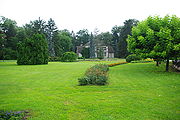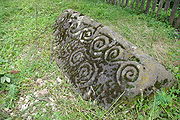
Banja Koviljaca
Encyclopedia

Serbia
Serbia , officially the Republic of Serbia , is a landlocked country located at the crossroads of Central and Southeast Europe, covering the southern part of the Carpathian basin and the central part of the Balkans...
. It is the oldest spa in Serbia. Banja Koviljača is located on the west border of Serbia by the Drina river, 137 kilometres from Belgrade
Belgrade
Belgrade is the capital and largest city of Serbia. It is located at the confluence of the Sava and Danube rivers, where the Pannonian Plain meets the Balkans. According to official results of Census 2011, the city has a population of 1,639,121. It is one of the 15 largest cities in Europe...
. The population of the town is 6,340 people (2002 census).
Name
Banja Koviljača means the "Koviljača Spa" in English. It is also known as Kraljevska Banja ("The Royal Spa").Features
Banja Koviljača has a number of sulphuric and iron-bearing thermal mineral springs, ranging in temperature from 21 to 38 degrees Celsius. Patients drink and bathe in these waters, which are also used for the preparation of mud packPeloid
thumb|Family of African Bush Elephants taking a mud bath in Tsavo East National Park, Kenya.Peloid is mud, or clay used therapeutically, as part of balneotherapy, or therapeutic bathing...
s.
The location of the spa was chosen for its useful natural elements: the Drina river, which could be forded
Ford (crossing)
A ford is a shallow place with good footing where a river or stream may be crossed by wading or in a vehicle. A ford is mostly a natural phenomenon, in contrast to a low water crossing, which is an artificial bridge that allows crossing a river or stream when water is low.The names of many towns...
; the wooded mountain
Mountain
Image:Himalaya_annotated.jpg|thumb|right|The Himalayan mountain range with Mount Everestrect 58 14 160 49 Chomo Lonzorect 200 28 335 52 Makalurect 378 24 566 45 Mount Everestrect 188 581 920 656 Tibetan Plateaurect 250 406 340 427 Rong River...
Gučevo
Gučevo
Gučevo is a mountain in western Serbia, near the town of Loznica, overlooking the Drina river and Banja Koviljača. Its highest peak Crni vrh has an altitude of 779 meters above sea level....
, which served as shelter from enemies; the plains, which supplied food; and the water, which was (and still is) considered to have medicinal properties.
History
Originally Town of Koviljka or Koviljkin gradKoviljkin grad
Koviljkin grad or Koviljka is a name for archaeological ruins close to Banja Koviljača in the Loznica district of western Serbia. The ruins are of a Roman town, which may have been named Gensis; the name has never been confirmed...
was built by the Romans, and there are some claims that the name of this Roman
Ancient Rome
Ancient Rome was a thriving civilization that grew on the Italian Peninsula as early as the 8th century BC. Located along the Mediterranean Sea and centered on the city of Rome, it expanded to one of the largest empires in the ancient world....
settlement is "Genzis", but it was never confirmed. The first document mentioning the spa was written in 1533.

Macva
Mačva is a geographical region in Serbia, mostly situated in the northwest of Central Serbia. It is located in a fertile plain between the Sava and Drina rivers. The chief town of this region is Šabac. The modern Mačva District of Serbia is named after the region, although the region of Mačva...
and Podrinje came to visit this region. Some documents state that in 1720 Turks from the city of Zvornik
Zvornik
Zvornik is a city on the Drina river in northeastern Bosnia and Herzegovina, located south of the town of Bijeljina in Bosnia and Herzegovina. The town Mali Zvornik lies directly across the river in Serbia, and not far north is Loznica.-History:Zvornik is first mentioned in 1410, although it was...
built a medical bathroom for women named the "Stinking Spa", due to the sulphuric water from the springs. A legend states that a caravan had been passing in the area and had to leave its horse behind, collapsed from exhaustion, rolling in the mud. It is said that when the caravan returned, the horse had been cured.
Vuk Stefanović Karadžić
Vuk Stefanovic Karadžic
Vuk Stefanović Karadžić was a Serbian philolog and linguist, the major reformer of the Serbian language, and deserves, perhaps, for his collections of songs, fairy tales, and riddles to be called the father of the study of Serbian folklore. He was the author of the first Serbian dictionary...
, describing this region in 1827, wrote about the sulfuric puddle and cold mineral springs. According to Karadžic, its real name, Spa, was derived from the old town, fortress, which had been built on the hill above the current Spa. According to Kanić, Spa received its name from a very popular plant kovilja (Stipa pennata
Stipa pennata
Stipa pennata, common name feather grass, is a flowering plant in the family Poaceae, which is grown as an ornamental plant for its feathery flowering spikes....
) which grows on nearby slopes and hills.
The first chemical analysis of the water was performed by the chemist Pavle Ilić in the year 1855. The first guest house was built in 1858 with ten rooms. In 1867, under the order of the duchy Mihailo Obrenović, the spa won state protection.
Modern development
Development of Banja Koviljača began on August 1, 1898, when a law was passed opening it to the people of the Podrinje district for exploration. Intensive development occurred until 1930, when Koviljača's jurisdiction was changed to Drinska Banovina, the capital in SarajevoSarajevo
Sarajevo |Bosnia]], surrounded by the Dinaric Alps and situated along the Miljacka River in the heart of Southeastern Europe and the Balkans....
.
Until 1970 this sanatorium operated under the name “Natural Sanatorium Spa Koviljača”. From 1970 to 1998, it was known as the “Institute for dissipated and post-traumatic conditions”.
In 1980, a facility for therapy and amenities was added. Since 1998 it has been called the “Special hospital for rehabilitation Spa Koviljača”. Medical services are provided by physicians of the Institute of Discopathy.
Geographical setting
Gučevo is a wooded mountain which rises above the Banja Koviljača Spa to the south. The mountain extends from northwest to southeast and from Koviljača to the mountain Boranja. It is 15 kilometers long. The peak of the Gučevo Mountain is Crni Vrh, and its altitude is 779 m above sea level. Mount Gučevo is composed mainly of limestone and sand.In the past, there was a terrain fissure on the mountain, which was significant to the occurrence of thermo-mineral waters. The mountain of Gučevo has many clear water springs which grow into smaller brooks overhung by high beech forests. The river Drina dominates the area and meanders between Mačva and Semberija.
Events
- International folk festival of EuropeEuropeEurope is, by convention, one of the world's seven continents. Comprising the westernmost peninsula of Eurasia, Europe is generally 'divided' from Asia to its east by the watershed divides of the Ural and Caucasus Mountains, the Ural River, the Caspian and Black Seas, and the waterways connecting...
an dances - August, Banja Koviljača, Loznica

